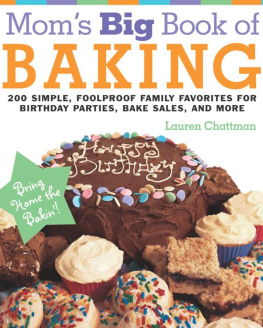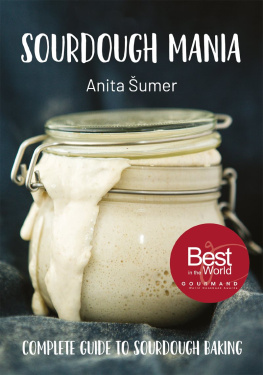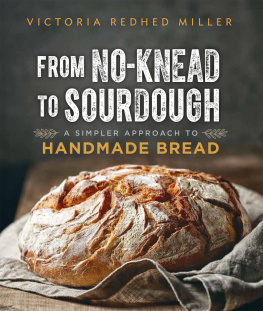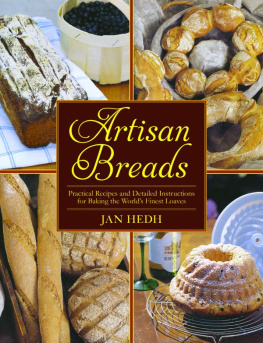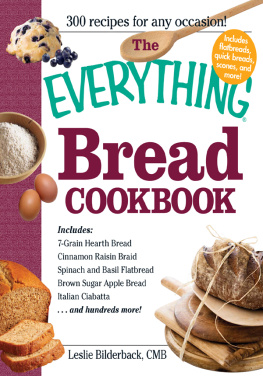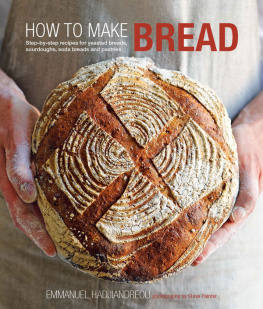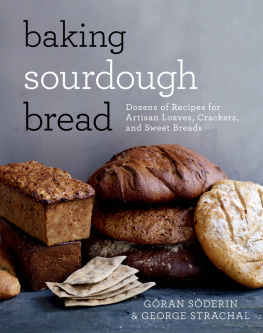Chattman - Bread Making: A Home Course
Here you can read online Chattman - Bread Making: A Home Course full text of the book (entire story) in english for free. Download pdf and epub, get meaning, cover and reviews about this ebook. City: Godalming;Pownal;Vt, year: 2005;2011, publisher: Storey Publishing, LLC;Melia [distributor], Storey, genre: Home and family. Description of the work, (preface) as well as reviews are available. Best literature library LitArk.com created for fans of good reading and offers a wide selection of genres:
Romance novel
Science fiction
Adventure
Detective
Science
History
Home and family
Prose
Art
Politics
Computer
Non-fiction
Religion
Business
Children
Humor
Choose a favorite category and find really read worthwhile books. Enjoy immersion in the world of imagination, feel the emotions of the characters or learn something new for yourself, make an fascinating discovery.

- Book:Bread Making: A Home Course
- Author:
- Publisher:Storey Publishing, LLC;Melia [distributor], Storey
- Genre:
- Year:2005;2011
- City:Godalming;Pownal;Vt
- Rating:4 / 5
- Favourites:Add to favourites
- Your mark:
- 80
- 1
- 2
- 3
- 4
- 5
Bread Making: A Home Course: summary, description and annotation
We offer to read an annotation, description, summary or preface (depends on what the author of the book "Bread Making: A Home Course" wrote himself). If you haven't found the necessary information about the book — write in the comments, we will try to find it.
Bread Making: A Home Course — read online for free the complete book (whole text) full work
Below is the text of the book, divided by pages. System saving the place of the last page read, allows you to conveniently read the book "Bread Making: A Home Course" online for free, without having to search again every time where you left off. Put a bookmark, and you can go to the page where you finished reading at any time.
Font size:
Interval:
Bookmark:
Bread
Making

A HOME COURSE
Making
Crafting the Perfect Loaf from Crust to Crumb
Lauren Chattman

The mission of Storey Publishing is to serve our customers by
publishing practical information that encourages
personal independence in harmony with the environment.
Edited by Margaret Sutherland and Molly Jackel
Art direction and book design by Dan O. Williams
Cover and interior photography by Dan O. Williams, except for back cover; authors photograph; and Darren Brode/iStockphoto.com: 51 bottom; Donald Erickson/iStockphoto.com: 47 bottom right; Homiel/iStockphoto.com: 50 second from top; Labazele/iStockphoto.com: 51 middle; Robin Maby/iStockphoto.com: 43 top, 44; Andrey Parfenov/iStockphoto.com: 55 bottom; Lauri Patterson/iStockphoto.com: 56 second from bottom; Sinankocaslan/iStockphoto.com: 46 bottom left, 56 third from top; EddWestmacott/iStockphoto.com: 55 top, 58 top
Illustrations by Alison Kolesar
Indexed by Christine R. Lindemer, Boston Road Communications
2011 by Lauren Chattman
All rights reserved. No part of this book may be reproduced without written permission from the publisher, except by a reviewer who may quote brief passages or reproduce illustrations in a review with appropriate credits; nor may any part of this book be reproduced, stored in a retrieval system, or transmitted in any form or by any means electronic, mechanical, photocopying, recording, or other without written permission from the publisher.
The information in this book is true and complete to the best of our knowledge. All recommendations are made without guarantee on the part of the author or Storey Publishing. The author and publisher disclaim any liability in connection with the use of this information.
Storey books are available for special premium and promotional uses and for customized editions. For further information, please call 1-800-793-9396.
Storey Publishing
210 MASS MoCA Way
North Adams, MA 01247
www.storey.com
Printed in the United States by Malloy
10 9 8 7 6 5 4 3 2 1
Library of Congress Cataloging-in-Publication Data
Chattman, Lauren.
Bread making : a home course/by Lauren Chattman.
p. cm.
Includes index.
ISBN 978-1-60342-791-3 (pbk. :alk. paper)
1. Bread. I. Title.
TX769.C4166 2011
641.8'15dc22
2010050577
STARTED

WHEN COMMERCIAL PRODUCTION of bread began in the midnineteenth century, our ancestors gladly shrugged off the responsibility of making bread for their households in favor of purchasing loaves from a local baker. Why not buy bread that was just as good as what could be made at home for the same price? There were more similarities than differences in the recipes of home and professional bakers at that point in our history.
As commercial baking grew into a mass industry, every innovation seemed to take bread further from its origins as a wholesome, homemade food. The industrialization of milling resulted in the removal of valuable nutrients from flour. Superheating the grain to speed up the process also damaged the starches to the point where they couldnt feed yeast as efficiently as before. The mechanization of mixing, kneading, and shaping bread dough required a certain kind of doughextensible so it could be extruded through a machine and quick-rising to speed up production. None of these changes were good for bread.
Most people have nothing against progress. Even the most avid home-makers are not nostalgic for the days of beating dirty laundry against a rock or building a fire to cook every meal. But many of us who grew up with preservative-packed sliced bread have welcomed the resurgence of old-fashioned bread baking. Artisan bakers have set up shop across the country, producing all-natural breads that havent been processed to within an inch of their nutritional lives. After tasting these beautiful and delicious breads, many home bakers have grown more interested in making quality bread at home. If you are among them, there is nothing to stop you from achieving and surpassing this modest goal. Flour with integrity is available in most supermarkets. Foolproof yeast sits near it in the baking aisle. But unless your parents run a bakery, you probably havent learned to bake bread from them. You have the will and access to good ingredients. You just need some tutoring in the basics of the craft.
Like wine and cheese, bread is fermented. All three rely on the activity of yeast to transform a foundational ingredientgrape juice, milk, flourinto an entirely different and much more delicious food. Not all wine and cheese are artisanalthere are plenty of mass-produced examples of both that rival Wonder bread in their banality. But there are many transcendent examples: a Lafite Bordeaux, a Montgomery cheddar. Bread experts argue that fine breads exhibit a complexity akin to these.
However, there is an important difference. While making a palatable wine or cheese can take hundreds of tries, and homemade wine and cheese rarely if ever achieve the excellence of a Lafite Bordeaux or a Montgomery cheddar, making great bread takes just a little knowledge of the basics of the process and a little experience to get a feel for bread dough. It is not inconceivable that after a few tries your bread will be as good as, or better than, anything you can buy at your local bakery. With some study and effort, you may even be able to bake breads that rival the loaves sold by Acme Bread Company in San Francisco, Amys Bread in New York, and even the legendary Poilne in Paris.
The wonderful thing about bread baking is that you can be as casual or serious as you like about it. This book is organized to help you find an entry point and to guide you to other places when you are ready. Maybe you just want to take some baby steps, because someones given you a bread machine as a holiday gift. Rather than just follow the recipes in the machines manual, spend a little time learning about the basics of bread baking, and you will be able to use your machine to craft exemplary loaves. Even if you make them start to finish in the machine, if you make them with knowledge and care they will have some artisanal flavor.
You may want to stop there, and thats fine. But I am betting that you will be so intrigued by what has occurred inside your machine that you will want to take the next step: mixing a simple straight dough, kneading it by machine or even by hand, and seeing what happens.
Maybe youve let that dough ferment overnight and are impressed by the dramatic improvement in your breads texture and flavor that has resulted from this simple technique. This may get you thinking about something you read about extended fermentation. You might take a look at a bread recipe made in two stages, with a simple sponge, and give it a try.
Then you think that it was so easy to mix that sponge a few hours before mixing the dough itself. You perhaps wonder what your two-stage dough would have been like if it had been raised with sourdough instead of a starter made with commercial yeast.
Next pageFont size:
Interval:
Bookmark:
Similar books «Bread Making: A Home Course»
Look at similar books to Bread Making: A Home Course. We have selected literature similar in name and meaning in the hope of providing readers with more options to find new, interesting, not yet read works.
Discussion, reviews of the book Bread Making: A Home Course and just readers' own opinions. Leave your comments, write what you think about the work, its meaning or the main characters. Specify what exactly you liked and what you didn't like, and why you think so.

